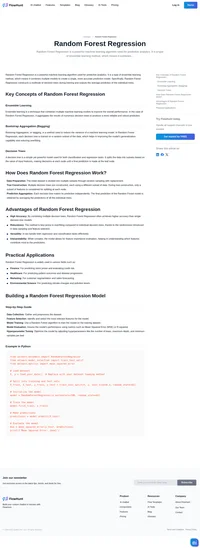Mean Absolute Error (MAE) is a fundamental metric in machine learning, particularly utilized in the evaluation of regression models. It measures the average magnitude of errors in a set of predictions, without considering their direction. This metric provides a straightforward way to quantify the accuracy of a model by calculating the mean of the absolute differences between predicted values and actual values. Unlike some other metrics, MAE does not square the errors, which means it places equal importance on all deviations, regardless of their size. This characteristic makes MAE particularly useful when assessing the magnitude of prediction errors without assigning different weights to overestimations or underestimations.
How is MAE Calculated?
The formula for MAE is expressed as:

Where:
- ( n ) represents the number of observations.
- ( y_i ) denotes the actual value.
- ( \hat{y}_i ) signifies the predicted value.
MAE is computed by taking the absolute value of each prediction error, summing these absolute errors, and then dividing by the number of predictions. This results in an average error magnitude that is easy to interpret and communicate.
Importance of MAE in AI Training
MAE holds significant importance in AI training due to its simplicity and interpretability. Its advantages include:
- Robustness to Outliers: Unlike Mean Squared Error (MSE), which squares the differences and is thus more sensitive to outliers, MAE treats all errors equally, making it less sensitive to extreme values.
- Interpretability: MAE is expressed in the same units as the target variable, making it easily interpretable. For instance, if a model predicts house prices in dollars, the MAE will also be in dollars, providing a clear understanding of the average prediction error.
- Applicability: MAE is extensively used across various domains, including finance, engineering, and meteorology, to evaluate regression models effectively.
Use Cases and Examples
- Model Evaluation: In practical scenarios, MAE is used to evaluate the performance of regression models. For instance, in predicting housing prices, an MAE of $1,000 indicates that, on average, the predicted prices deviate from the actual prices by $1,000.
- Comparison of Models: MAE serves as a reliable metric for comparing the performance of different models. A lower MAE suggests better model performance. For example, if a Support Vector Machine (SVM) model yields an MAE of 28.85 degrees in predicting temperature, whereas a Random Forest model results in an MAE of 33.83 degrees, the SVM model is deemed more accurate.
- Real-World Applications: MAE is employed in various applications such as radiation therapy, where it is used as a loss function in deep learning models like DeepDoseNet for 3D dose prediction, outperforming models that use MSE.
- Environmental Modeling: In environmental modeling, MAE is used to assess uncertainties in predictions, offering a balanced representation of errors compared to RMSE.
Comparison with Other Metrics
- Mean Squared Error (MSE): Unlike MAE, MSE squares the differences, penalizing larger errors more heavily. This makes MSE more sensitive to outliers, useful when large errors are particularly undesirable.
- Root Mean Squared Error (RMSE): RMSE is the square root of MSE, providing error measures in the same unit as the data. It penalizes large errors more than MAE, making it suitable for applications where large deviations are critical.
- Mean Absolute Percentage Error (MAPE): MAPE expresses errors as a percentage, offering a relative measure of error. It is equivalent to weighted MAE regression and is useful for assessing model accuracy in percentage terms.
Implementation Example in Python
MAE can be calculated using Python’s sklearn library as follows:
from sklearn.metrics import mean_absolute_error
import numpy as np
# Sample data
y_true = np.array([1, 2, 3, 4, 5])
y_pred = np.array([1.5, 2.5, 2.8, 4.2, 4.9])
# Calculate MAE
mae = mean_absolute_error(y_true, y_pred)
print("Mean Absolute Error:", mae)
When to Use MAE?
MAE is ideal when:
- The objective is to evaluate the absolute magnitude of prediction errors.
- The dataset contains outliers that might skew squared error metrics like MSE.
- Interpretability in the same unit as the target variable is desired.
Limitations of MAE
While MAE is versatile and widely used, it has limitations:
- It does not provide information about the direction of the error (over- or under-prediction).
- It treats all errors equally, which might not be ideal in scenarios where larger errors need more penalization.
Research on Mean Absolute Error in AI Training
Mean Absolute Error (MAE) is a widely used metric in AI training, particularly in evaluating the accuracy of predictive models. Below is a summary of recent research involving MAE:
- Generative AI for Fast and Accurate Statistical Computation of Fluids
This paper introduces a generative AI algorithm named GenCFD, designed for fast and accurate statistical computation of turbulent fluid flows. The algorithm leverages a conditional score-based diffusion model to achieve high-quality approximations of statistical quantities, including mean and variance. The study highlights that traditional operator learning models, which often minimize mean absolute errors, tend to regress to mean flow solutions. The authors present theoretical insights and numerical experiments showcasing the algorithm’s superior performance in generating realistic fluid flow samples. Read the paper. - AI-Powered Dynamic Fault Detection and Performance Assessment in Photovoltaic Systems
This research focuses on enhancing fault detection in photovoltaic systems using AI, particularly through machine learning algorithms. The study emphasizes the importance of accurately characterizing power losses and detecting faults to optimize performance. It reports the development of a computational model that achieves a mean absolute error of 6.0% in daily energy estimation, demonstrating the effectiveness of AI in fault detection and system performance assessment. Read the paper. - Computationally Efficient Machine-Learning-Based Online Battery State of Health Estimation
The paper explores data-driven methods for estimating the state of health (SoH) of batteries in e-mobility applications. It discusses the use of machine learning techniques to enhance the accuracy of SoH estimation, which is traditionally performed using model-based methods. The research highlights the potential of reducing mean absolute errors in battery management systems through advanced AI algorithms. Read the paper.

